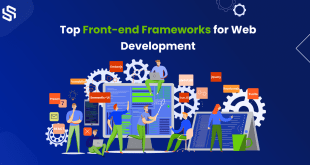In the ever-evolving landscape of frontend development, the quest to provide users with unparalleled experiences has led to the integration of Augmented Reality (AR) and Virtual Reality (VR) technologies into frontend frameworks. These immersive technologies have the potential to revolutionize user interactions with web applications, bringing a new dimension to how users perceive and engage with digital content. In this blog, we delve into the fascinating world of AR and VR integration, with a primary focus on React JS, one of the most popular frontend frameworks in the industry.
Understanding AR and VR: Unraveling the Technologies
To embark on our journey, let’s first grasp the fundamental concepts of Augmented Reality and Virtual Reality. AR enriches the real-world environment by overlaying digital elements, such as graphics and information, onto the physical world, creating an interactive and immersive experience. VR, on the other hand, submerges users into entirely simulated environments, detached from the physical reality, offering a captivating and lifelike encounter.
Both AR and VR can elevate frontend experiences by introducing dynamic and interactive elements that captivate users, making them feel more connected to the application.
The Synergy Between AR/VR and Frontend Frameworks
As frontend developers seek innovative ways to engage users, the integration of AR and VR into frontend frameworks becomes a compelling prospect. React JS, renowned for its component-based architecture and seamless rendering, proves to be an excellent candidate for this fusion.
React JS opens up a world of possibilities with its ability to handle complex UI interactions effortlessly. By integrating AR/VR technologies into React components, developers can create rich, interactive user interfaces that leave a lasting impact on users.
AR/VR-Powered Features in Frontend Frameworks
Let’s delve into the AR/VR-powered features that can be incorporated into frontend frameworks like React JS:
Immersive Product Visualization
AR empowers users to visualize products in their real-life environment, bridging the gap between online shopping and physical retail. By leveraging React JS, developers can seamlessly integrate AR-powered product visualization into eCommerce applications, allowing users to preview products before making a purchase.
Interactive Virtual Tours
VR-driven virtual tours offer a captivating way for users to explore real estate properties, museums, travel destinations, and more. By integrating VR capabilities with React components, developers can create smooth, interactive virtual tours that provide users with an unparalleled sense of presence.
Gamification and Enhanced Interactivity
AR/VR brings an element of gamification and enhanced interactivity to web applications. By incorporating React JS, developers can build engaging games and interactive experiences that keep users entertained and immersed in the application.
Enhanced Training and Education
AR/VR integration enables the creation of immersive training and educational experiences. By using React JS to build interactive learning modules, developers can enhance user engagement and knowledge retention.
Overcoming Challenges in AR/VR Integration
While the potential for elevating user experiences is vast, AR/VR integration in frontend frameworks does come with its challenges. Some common hurdles include:
Performance Optimization
AR/VR experiences demand substantial computational power, which can affect performance. By employing React JS optimizations and leveraging WebXR APIs, developers can strive to ensure smooth and responsive experiences.
Cross-Platform Compatibility
Ensuring seamless AR/VR experiences across different devices and browsers requires careful consideration. React JS’s cross-platform capabilities can significantly aid in achieving compatibility.
User Familiarity and Adoption
AR/VR technologies, while promising, are still relatively new to many users. Striking a balance between novelty and familiarity is crucial to encourage user adoption.
Embracing the Future of Frontend Development
As AR and VR technologies continue to mature and gain traction, their integration into frontend frameworks like React JS holds incredible potential for reshaping user experiences. Developers who embrace these immersive technologies and harness the power of React JS can unlock new frontiers of creativity and engagement.
Final Words
The marriage of AR/VR and frontend frameworks marks a turning point in web development, ushering in a new era of interactive and captivating user experiences. React JS emerges as a prominent player in this realm, enabling developers to create immersive applications that leave a lasting impression on users. As we journey into the future, the fusion of AR/VR and frontend frameworks holds the promise of shaping a more exciting and engaging digital landscape.
Asked Questions
Q1: Is React JS the only frontend framework compatible with AR/VR integration?
A1: While React JS is one of the most popular and suitable frameworks for AR/VR integration, other frameworks like Vue.js and A-Frame also offer support for immersive technologies.
Q2: Are there any ready-to-use AR/VR libraries for React JS?
A2: Yes, several AR/VR libraries, such as React 360 and AR.js, are specifically designed for seamless integration with React JS applications.
Q3: How can AR/VR integration benefit businesses?
A3: AR/VR integration can enhance product visualization, improve user engagement, and create unique marketing opportunities, ultimately leading to increased customer satisfaction and brand loyalty.
Q4: Are there any performance concerns with AR/VR applications built on React JS?
A4: AR/VR applications may require optimized rendering and performance enhancements to ensure a smooth user experience. By employing React JS’s performance optimization techniques, developers can mitigate these concerns.
Q5: Can AR/VR technologies be applied to non-entertainment industries?
A5: Absolutely! AR/VR technologies have practical applications in industries like healthcare, education, training, and real estate, offering innovative solutions and enhanced experiences.
 webfily
webfily



